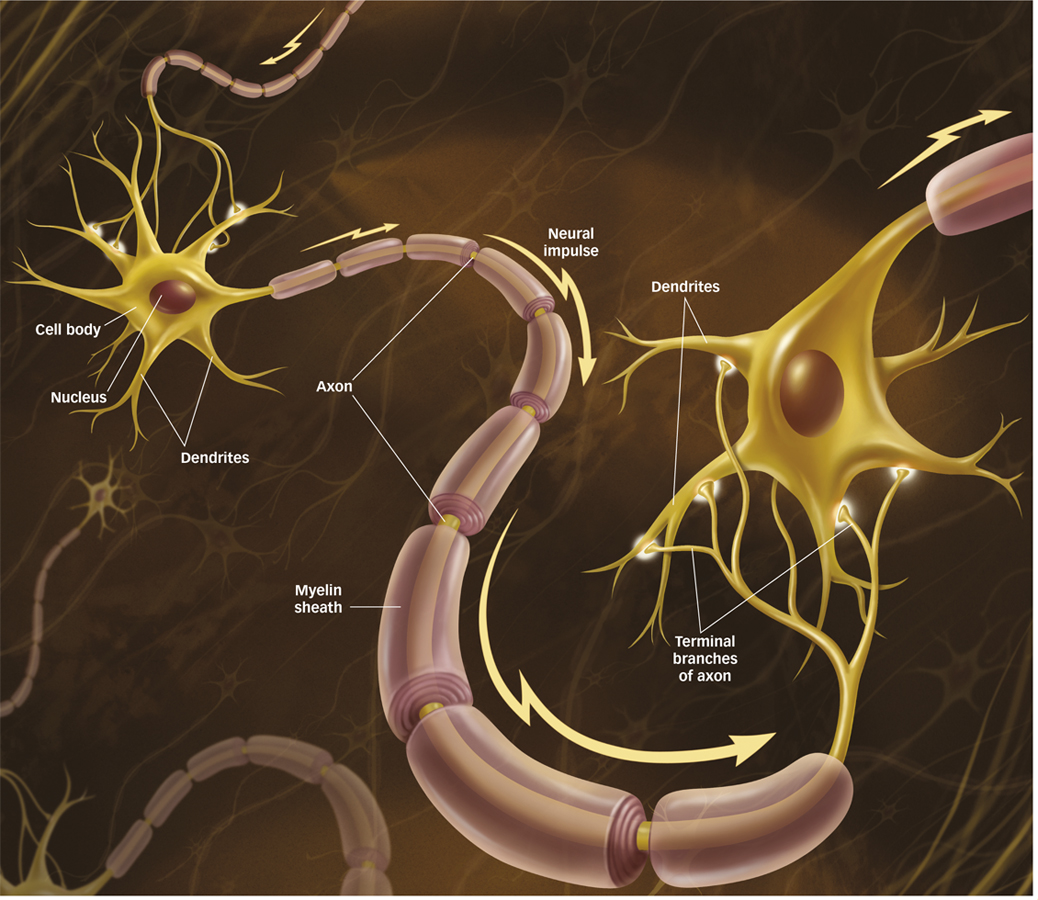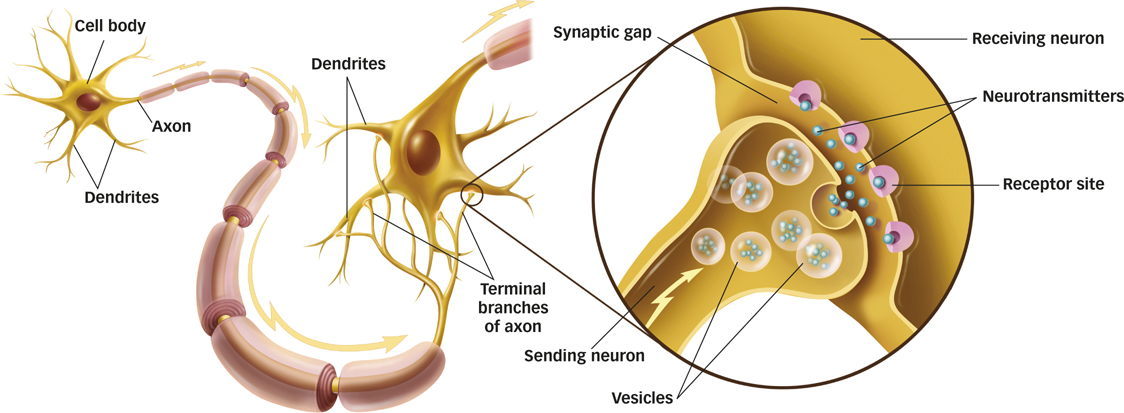3.1 Neurons: The Origin of Behavior
An estimated 1 billion people watch the final game of World Cup soccer every 4 years. That’s a whole lot of people, but it’s still only a little over 14% of the estimated 7 billion people or more currently living on Earth. But a really, really big number is inside your skull right now. There are approximately 100 billion nerve cells in your brain that perform a variety of tasks to allow you to function as a human being. All of your thoughts, feelings, and behaviors spring from cells in the brain that take in information and produce some kind of output trillions of times a day. These cells are neurons, cells in the nervous system that communicate with one another to perform information-
neurons
Cells in the nervous system that communicate with one another to perform information-
Components of the Neuron
Neurons are complex structures composed of three basic parts: the cell body, the dendrites, and the axon (see FIGURE 3.1). Like cells in all organs of the body, neurons have a cell body (also called the soma), the largest component of the neuron that coordinates the information-
cell body (or soma)
The part of a neuron that coordinates information-

Which components allow neurons to communicate?
Unlike other cells in the body, neurons have two types of specialized extensions of the cell membrane that allow them to communicate: dendrites and axons. Dendrites receive information from other neurons and relay it to the cell body. The term dendrite comes from the Greek word for “tree”; indeed, most neurons have many dendrites that look like tree branches. The axon carries information to other neurons, muscles, or glands. Axons can be very long, even stretching up to a meter from the base of the spinal cord down to the big toe. The dendrites and axons of neurons do not actually touch each other. There’s a small gap between the axon of one neuron and the dendrites or cell body of another. This gap is part of the synapse, the junction or region between the axon of one neuron and the dendrites or cell body of another (see FIGURE 3.2). Many of the 100 billion neurons in your brain have a few thousand synaptic junctions, so it should come as no shock that most adults have 100 to 500 trillion synapses. As you’ll read shortly, the transmission of information across the synapse is fundamental to communication between neurons, a process that allows us to think, feel, and behave.
dendrites
The part of a neuron that receives information from other neurons and relays it to the cell body.
axon
The part of a neuron that carries information to other neurons, muscles, or glands.
synapse
The junction or region between the axon of one neuron and the dendrites or cell body of another.

In many neurons, the axon is covered by a myelin sheath, an insulating layer of fatty material. The myelin sheath is composed of glial cells (named for the Greek word for “glue”), which are support cells found in the nervous system. Although there are 100 billion neurons busily processing information in your brain, there are 10 to 50 times that many glial cells serving a variety of functions. Some glial cells digest parts of dead neurons, others provide physical and nutritional support for neurons, and others form myelin to help the axon carry information more efficiently. An axon insulated with myelin can more efficiently transmit signals to other neurons, organs, or muscles. In fact, with demyelinating diseases, such as multiple sclerosis, the myelin sheath deteriorates, slowing the transmission of information from one neuron to another (Schwartz & Westbrook, 2000). This kind of damage leads to a variety of problems, including loss of feeling in the limbs, partial blindness, and difficulties in coordinated movement and cognition (Butler, Corboy, & Filley, 2009).
myelin sheath
An insulating layer of fatty material.
glial cells
Support cells found in the nervous system.
57
58
Major Types of Neurons
How do the three types of neurons work together to transmit information?
There are three major types of neurons, each performing a distinct function: sensory neurons, motor neurons, and interneurons. Sensory neurons receive information from the external world and convey this information to the brain via the spinal cord. They have specialized endings on their dendrites that receive signals for light, sound, touch, taste, and smell. Motor neurons carry signals from the spinal cord to the muscles to produce movement. These neurons often have long axons that can stretch to muscles at our extremities. However, most of the nervous system is composed of the third type of neuron, interneurons, which connect sensory neurons, motor neurons, or other interneurons. Some interneurons carry information from sensory neurons into the nervous system, others carry information from the nervous system to motor neurons, and still others perform a variety of information-
sensory neurons
Neurons that receive information from the external world and convey this information to the brain via the spinal cord.
motor neurons
Neurons that carry signals from the spinal cord to the muscles to produce movement.
interneurons
Neurons that connect sensory neurons, motor neurons, or other interneurons.
SUMMARY QUIZ [3.1]
Question 3.1
| 1. | Which of the following is NOT a function of a neuron? |
- processing information
- communicating with other neurons
- nutritional provision
- sending messages to body organs and muscles
c.
Question 3.2
| 2. | Signals from other neurons are received and relayed to the cell body by |
- the nucleus.
- dendrites.
- axons.
- glands.
b.
59
Question 3.3
| 3. | Signals are transmitted from one neuron to another |
- across a synapse.
- through a glial cell.
- by the myelin sheath.
- in the cell body.
a.
Question 3.4
| 4. | Which type of neuron receives information from the external world and conveys this information to the brain via the spinal cord? |
- sensory neuron
- motor neuron
- interneuron
- axon
a.